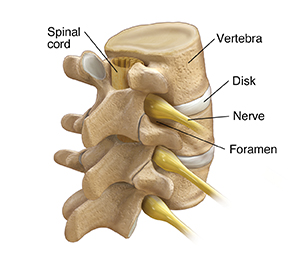Having a Foraminotomy
A foraminotomy is a surgery to widen an area in one of your spinal bones (vertebrae). This takes pressure off a nerve that is squeezed (compressed) by the bone.

What to tell your healthcare provider
Tell your healthcare provider about all the medicines you take. This includes over-the-counter medicines, such as ibuprofen and aspirin. It also includes vitamins, herbs, and other supplements. And tell your healthcare provider if you:
-
Have had any recent changes in your health, such as an infection or fever
-
Are sensitive or allergic to any medicines, latex, tape, or anesthesia (local and general)
-
Are pregnant or think you may be pregnant
Tests before your surgery
Before your surgery, you may need imaging tests, such as an MRI or CT scan.
Getting ready for your surgery
Talk with your healthcare provider how to get ready for your surgery. You may need to stop taking some medicines before the procedure, such as blood thinners and aspirin. If you smoke, you may need to stop before your surgery. Smoking can delay healing. Talk with your healthcare provider if you need help to stop smoking.
Also, be sure to:
-
Ask a family member or friend to take you home from the hospital. You can't drive yourself.
-
Plan some changes at home to help you recover. You may need help at home.
-
Follow any directions you are given for not eating or drinking before your surgery.
-
Follow all other directions from your healthcare provider.
You will be asked to sign a consent form that gives your permission to do the procedure. Read the form carefully. Ask questions if something is not clear.
On the day of your surgery
Your healthcare provider can help explain the details of your surgery. A neurosurgeon and a team of specialized nurses will do the surgery. The procedure will take about 2 hours. For a minimally invasive type of foraminotomy you can expect:
-
During the procedure, you’ll lie on your stomach. The surgery can also be done when you are lying on your side.
-
You will get anesthesia to help you sleep through the surgery. You won’t feel any pain.
-
A healthcare provider will carefully watch your vital signs, such as heart rate and blood pressure.
-
Your surgeon will make small cuts in the skin just beside your spine, near where you were feeling symptoms. They will make the cuts at the level of your affected vertebra.
-
Your surgeon will use X-rays or a 3-D navigation system using your MRI or CT scan images. Loupes or an operating microscope might be used during the surgery.
-
Using special tools, your surgeon will push away the back muscles around your spine to reach the blocked foramen.
-
Your surgeon will use small tools to increase the size of the foramen. To do this, the surgeon removes part of the lamina and the facet (the joint with the next vertebra) overlying the foramen. This procedure is called laminotomy and partial foraminotomy. The surgeon may also remove bone spurs or a bulging disk. This will relieve pressure on the nerve root.
-
In some cases, your surgeon might have to remove more bone. This procedure is called a laminectomy and foraminotomy.
-
The team will remove the tools and put your back muscles back in place. The small incision in your skin will be closed with stitches, staples or glue.
After your surgery
Talk with your healthcare provider about what to expect. You should be able to sit up in bed within a couple of hours. You might have a little pain, but you can have medicines to help ease pain. You should be able to eat a normal diet.
You’ll need to move around carefully as advised. Your healthcare provider will tell you if you need to not do any specific movements. For example, you may be told to not bend your neck. You also may need a soft or hard neck collar if the surgery was in your neck.
Recovering at home
You should be able to go home 1 or 2 days after your surgery. Be sure to follow all of your healthcare provider’s directions about medicines, physical activity, and wound care. You may need to not move in a certain way for a while. You may be able to do light lifting in a few weeks. But you may need to not do heavier lifting for a few months. You may need physical therapy as you recover.
Follow-up care
Your healthcare provider can tell you what to expect after your surgery. Your spinal stenosis symptoms may get better quickly. Make sure to keep all of your follow-up appointments.
When to call your healthcare provider
Call your healthcare provider right away if any of the following occur:
-
Fever of 100.4°F (38.0°C) or higher, or as advised by your healthcare provider
-
Symptoms that don’t get better
-
Pain that is getting worse
-
New symptoms